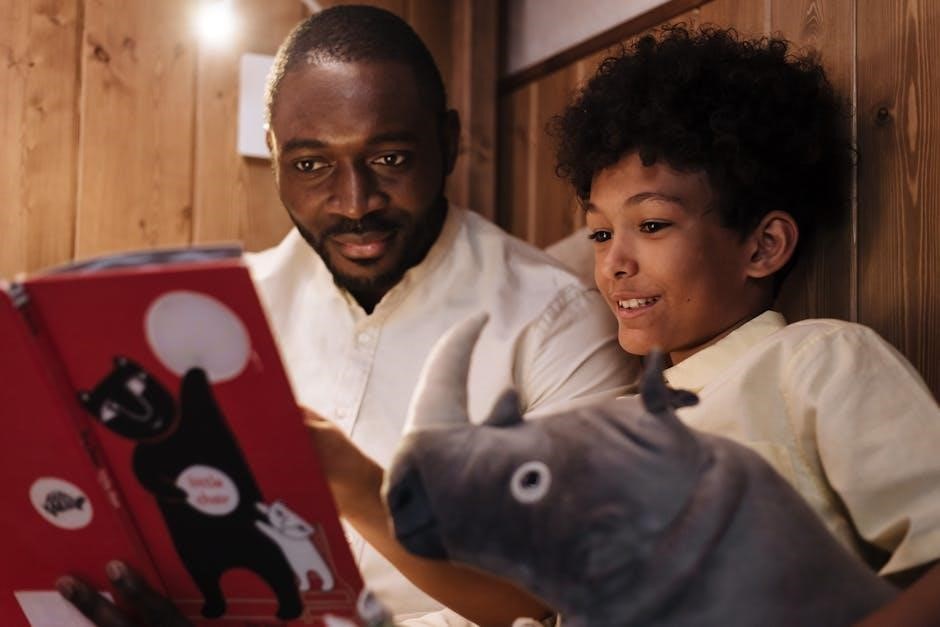Jack and the Beanstalk Story PDF: A Comprehensive Guide
Embark on a magical journey with our comprehensive guide to “Jack and the Beanstalk” in PDF format. Explore the timeless tale, its origins, and various adaptations, all available for easy download and reading. Discover resources for educators and enthusiasts alike, bringing this classic story to life.
Origins and History of “Jack and the Beanstalk”
The enchanting narrative of “Jack and the Beanstalk” boasts a rich history, its roots entwined with folklore traditions spanning centuries. While the exact origin remains debated, scholars trace elements of the tale back to ancient stories and myths. One compelling theory suggests connections to the folktale “Jack the Giant Killer,” highlighting a shared theme of a clever protagonist overcoming formidable giants.
The story’s popularity surged through oral tradition, evolving with each retelling across different cultures. It wasn’t until the 18th century that “Jack and the Beanstalk” appeared in written form, solidifying its place in literary history. Benjamin Tabart’s “The History of Jack and the Bean-Stalk” marked a significant milestone, bringing the tale to a wider audience.
Over time, the story continued to evolve, adapting to changing social contexts and values. Moral lessons and themes were emphasized, shaping the narrative into the beloved children’s story we know today. The enduring appeal of “Jack and the Beanstalk” lies in its timeless themes of courage, resourcefulness, and the triumph of good over evil, captivating readers of all ages.
Different Versions and Adaptations of the Story
“Jack and the Beanstalk” has proven to be a remarkably adaptable tale, spawning countless versions and adaptations across various media. From classic literature to modern films, the story’s core elements have been reimagined in diverse and creative ways. Traditional versions often focus on Jack’s bravery and cunning, emphasizing the moral lessons of resourcefulness and overcoming adversity.
However, more contemporary adaptations may explore darker themes, delving into the giant’s motivations and the ethical implications of Jack’s actions. Some versions introduce new characters or subplots, adding layers of complexity to the original narrative. Animated films and stage productions offer visually stunning interpretations, captivating audiences with imaginative settings and memorable characters.
Furthermore, “Jack and the Beanstalk” has inspired numerous parodies and satirical takes, poking fun at the story’s familiar tropes. These adaptations often subvert expectations, offering humorous and thought-provoking commentary on the original tale. Whether it’s a faithful retelling or a radical reimagining, “Jack and the Beanstalk” continues to inspire creativity and innovation, ensuring its enduring appeal for generations to come. The story’s adaptability is a testament to its timeless themes and universal appeal.
Key Characters: Jack, the Mother, and the Giant
The enduring appeal of “Jack and the Beanstalk” rests significantly on its memorable characters. Jack, the protagonist, embodies youthful curiosity and a thirst for adventure. He is often portrayed as a resourceful and quick-witted boy who makes impulsive decisions, leading to both trouble and triumph. His journey from poverty to prosperity highlights his growth and development throughout the story.
Jack’s mother represents the struggles of single parenthood and the burden of poverty. Her initial disapproval of Jack’s actions stems from her desire to protect him and secure their livelihood. However, she ultimately supports his endeavors, demonstrating her unwavering love and belief in his potential. The giant, a fearsome and imposing figure, serves as the primary antagonist.
He embodies greed, power, and the dangers of unchecked ambition. His presence creates a sense of tension and suspense, driving the plot forward. While often depicted as a one-dimensional villain, some interpretations explore the giant’s motivations, adding layers of complexity to his character. The interactions between Jack, his mother, and the giant form the core of the story, highlighting themes of courage, family, and the triumph of good over evil. Their dynamic relationships contribute to the story’s lasting impact.
The Significance of the Magic Beans
The magic beans in “Jack and the Beanstalk” serve as a pivotal plot device and a rich symbol within the narrative. They represent potential, opportunity, and the allure of the unknown. Initially dismissed as worthless by Jack’s mother, the beans possess a hidden power that transforms their circumstances. This highlights the theme that appearances can be deceiving, and true value may lie beneath the surface.
The beans act as a catalyst for Jack’s adventure, propelling him into a world of giants, castles, and unimaginable riches. They symbolize the possibility of escaping poverty and achieving a better life, a common aspiration in many folktales. Furthermore, the beans can be interpreted as a symbol of risk-taking and the willingness to embrace the unconventional. Jack’s decision to trade the family cow for the beans, despite the apparent lack of logic, demonstrates his adventurous spirit and his belief in the extraordinary.
The rapid growth of the beanstalk from the magic beans signifies the transformative power of belief and the potential for rapid change. The beanstalk itself becomes a physical manifestation of Jack’s hopes and dreams, connecting the mundane world with the realm of fantasy and possibility. Thus, the magic beans are not merely a plot device but a potent symbol of hope, opportunity, and the transformative power of belief.
The Beanstalk as a Symbol
The beanstalk in “Jack and the Beanstalk” is a potent symbol that transcends its literal function as a means of transportation. It represents a bridge between the ordinary world and the extraordinary, connecting Jack’s impoverished reality to a realm of wealth, danger, and the unknown. The beanstalk’s rapid and unnatural growth symbolizes the potential for sudden and dramatic change, fueled by the magic beans and Jack’s own ambition.
It can be interpreted as a symbol of aspiration and the human desire to reach for something beyond one’s grasp. Jack’s climb represents the challenges and obstacles one faces when pursuing dreams, as he encounters difficulties and dangers along the way. The beanstalk also embodies the concept of risk-taking, as Jack ventures into uncharted territory with no guarantee of success or safety.
Furthermore, the beanstalk can be seen as a symbol of social mobility, offering Jack a chance to escape his poverty-stricken life and ascend to a higher social status. However, this ascent is not without its moral complexities, as Jack’s actions in the giant’s castle raise questions about the ethics of acquiring wealth. Ultimately, the beanstalk serves as a powerful and multifaceted symbol, representing opportunity, ambition, risk, and the complex relationship between the ordinary and the extraordinary.

Plot Summary: Jacks Journey and Encounters
Plot Summary: Jack’s Journey and Encounters
Jack’s journey begins with a desperate situation: his family’s poverty forces him to sell their cow. Instead, he trades it for magic beans, much to his mother’s dismay. She throws them out, but overnight, a giant beanstalk sprouts, reaching into the sky. Driven by curiosity and perhaps a touch of desperation, Jack climbs the beanstalk, entering a world above the clouds.
At the top, he finds a castle belonging to a giant. He encounters the giant’s wife, who initially helps him by providing food. During his visits, Jack steals valuable items: a bag of gold, a goose that lays golden eggs, and a magical harp. Each time, he narrowly escapes the giant’s pursuit. The harp’s cry alerts the giant, leading to a thrilling chase down the beanstalk.
Back on the ground, Jack chops down the beanstalk, causing the giant to fall to his death. He returns home with the stolen treasures, which provide his family with wealth and security, transforming their lives forever. Jack’s encounters with the giant and his wife are fraught with danger, testing his courage and resourcefulness.
Moral Lessons and Themes in the Story
“Jack and the Beanstalk” is rich with moral lessons and enduring themes. One prominent theme is resourcefulness. Jack’s ability to find solutions in difficult situations, like trading the cow for beans and later outsmarting the giant, highlights the importance of thinking creatively. The story also touches upon the theme of courage, as Jack faces the giant despite the obvious danger, demonstrating bravery in the face of adversity.
Another significant theme is social mobility. Jack’s journey from poverty to prosperity, achieved through his adventures, reflects the possibility of changing one’s circumstances through initiative and risk-taking. However, the story also presents a complex view of morality. While Jack’s actions provide for his family, they involve theft and ultimately lead to the giant’s demise, raising questions about the ethics of his choices.
The tale explores the consequences of greed, embodied by the giant, whose insatiable desire for possessions ultimately leads to his downfall. The story subtly suggests that true wealth lies not in material possessions but in cleverness and bravery. Thus, “Jack and the Beanstalk” offers a nuanced exploration of moral values.
Analyzing the Giants Castle and Treasures

Analyzing the Giant’s Castle and Treasures
The giant’s castle in “Jack and the Beanstalk” is not merely a dwelling but a symbol of power, wealth, and the abuse of both. Perched atop the beanstalk, it represents a world far removed from Jack’s humble home, a realm of unimaginable riches and formidable danger. The castle’s imposing structure reflects the giant’s dominance and the challenges Jack must overcome.
The treasures within – the golden hen that lays golden eggs, the self-playing harp, and bags of gold – are significant. The hen symbolizes endless wealth and prosperity. The harp represents art, beauty, and perhaps a more refined life. The bags of gold are a clear representation of material wealth. These treasures, stolen from others, highlight the giant’s greed and the unjust accumulation of wealth.
Analyzing these treasures reveals a deeper commentary on societal values and the allure of riches. Jack’s acquisition of these items can be viewed as a redistribution of wealth, challenging the giant’s tyrannical hold. However, it also raises ethical questions about the means by which this redistribution is achieved, adding layers of complexity to the narrative.
The Climax: Jacks Escape and the Giants Downfall

The Climax: Jack’s Escape and the Giant’s Downfall

The climax of “Jack and the Beanstalk” is a thrilling sequence of events, marked by Jack’s daring escape and the dramatic downfall of the giant. After securing the treasures, Jack’s descent down the beanstalk becomes a race against time, as the pursuing giant threatens to capture him and reclaim his stolen goods. This chase embodies the struggle between the powerless and the powerful, the quick-witted and the brute.
As Jack reaches the ground, he calls out to his mother for an axe, symbolizing the necessary tools to confront and overcome the giant’s oppressive force. The felling of the beanstalk is a pivotal moment, representing the destruction of the bridge between the ordinary world and the extraordinary realm of the giant.
The giant’s subsequent fall is a dramatic and decisive conclusion, signifying the defeat of tyranny and the restoration of balance. This downfall is not merely a physical event but a symbolic representation of the triumph of good over evil, the victory of the underdog, and the consequences of greed and exploitation. Jack’s actions ensure a future of prosperity and security for himself and his mother, marking a satisfying resolution to their initial poverty.
Educational Resources: “Jack and the Beanstalk” PDF Downloads
Unlock a wealth of learning opportunities with our curated collection of “Jack and the Beanstalk” PDF downloads, designed to enhance educational experiences for children of all ages. These resources offer a diverse range of materials, including beautifully illustrated storybooks, engaging activity sheets, and comprehensive lesson plans, perfect for both classroom and home use.
Our PDF downloads provide valuable tools for educators to explore key themes such as courage, resourcefulness, and the consequences of greed. Activity sheets include puzzles, coloring pages, and writing prompts that encourage critical thinking and creative expression. Lesson plans offer structured guidance for teachers, incorporating discussions, group activities, and assessment strategies to maximize student engagement and comprehension.
Whether you’re a teacher looking to enrich your fairy tale unit or a parent seeking fun and educational activities for your child, our “Jack and the Beanstalk” PDF downloads are an invaluable resource. Access a variety of versions and adaptations, catering to different reading levels and learning styles, ensuring that every child can enjoy and learn from this timeless classic. Download today and embark on an enchanting educational adventure!
Modern Interpretations and Relevance of the Tale
“Jack and the Beanstalk,” though a classic fairy tale, continues to resonate with modern audiences through its adaptable themes and enduring appeal. Contemporary interpretations often explore the story’s underlying messages of social mobility, challenging authority, and the pursuit of dreams, providing fresh perspectives on Jack’s journey and the giant’s downfall.
In today’s world, Jack can be seen as a symbol of entrepreneurial spirit, taking risks and seizing opportunities to improve his circumstances. The beanstalk itself represents the potential for growth and upward mobility, while the giant embodies the obstacles and challenges that individuals face in their quest for success. Modern adaptations may also address issues of environmentalism, consumerism, and the importance of ethical decision-making.
Moreover, “Jack and the Beanstalk” remains relevant in education, teaching children about problem-solving, courage, and the importance of standing up for what is right. The story’s fantastical elements spark imagination and creativity, encouraging young readers to explore new worlds and possibilities. By examining the tale through a contemporary lens, we can uncover new layers of meaning and appreciate its continued significance in shaping our understanding of the world around us.
